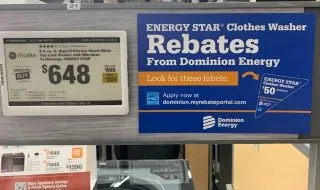What Does the ENERGY STAR Label Mean?
If you’ve shopped for appliances, electronics, or other major products for the home in the last 20+ years, chances are you’ve seen or heard references to ENERGY STAR. But what does that little blue label actually mean when you see it on a website, product package, ad, or store display?

For over 25 years, ENERGY STAR has been the government-backed symbol for superior energy efficiency. You can find the ENERGY STAR label on commercial and industrial buildings, new homes, and across 75 different types of products for consumers and businesses. While you can encounter it associated with many products, ENERGY STAR is not a manufacturer, seller, or installer of products. Rather, ENERGY STAR operates as an objective and data-based certification for energy efficiency. The program partners with manufacturers, retailers, and service providers to offer more energy efficient product options to consumers and businesses in the marketplace. Over its long history, the ENERGY STAR label and certification program has helped to empower American consumers by providing objective guidance and resources to help them improve the energy efficiency of their homes and reduce their carbon footprints.
Here’s a deeper dive into what the ENERGY STAR label means and why you should look for it when shopping for products for the home:
1) It means energy efficiency, made easy.
Looking for the ENERGY STAR label makes it easy to identify products with superior energy efficiency – products that save energy, save money and help protect the environment. The ENERGY STAR program saves consumers from the effort of looking at individual efficiency ratings by reviewing efficiency performance across the range of models in a product category and associating the little blue label with top performers. You can often find the ENERGY STAR label on the eligible products or product packaging, but you can also consult the ENERGY STAR Product Finder to identify products that have been certified.
2) Products that have earned the ENERGY STAR have been independently certified to meet strict energy efficiency standards.
Across more than 75 different categories, products that earn the ENERGY STAR label meet strict standards for energy efficiency that the Environmental Protection Agency (EPA) develops and regularly updates with consideration to technology improvements, market trends, and input from manufacturers and a range of stakeholders. Before associating the label with any product model, manufacturers must submit performance data from an EPA-recognized laboratory to an independent certification body for review, to ensure the product meets ENERGY STAR standards tailored for the category it’s in.
When you choose a product with the ENERGY STAR label, you can be confident that it has been independently evaluated to perform at a more efficient rate than a standard product.
3) Choosing ENERGY STAR means access to utility rebates, federal tax credits, and other ways to save.

When you think about saving money on an appliance or home project, it’s likely the first thing that comes to mind is looking for deals available through a retailer or straight from the manufacturer. For products that have earned ENERGY STAR certification, there are other ways to save on these purchases - such as rebates from your local utility, and tax credits, which have been extended and increased through the Inflation Reduction Act.
There are a number of ENERGY STAR certified product categories that qualify for a federal tax credit, including products for inside your home, as well as improvements to a home’s envelope or exterior – such as windows, doors, insulation, and similar items. For more information, check out ENERGY STAR’s guidance on federal tax credits.
Related articles: What are the differences between ENERGY STAR and Energy Guide?
Author


